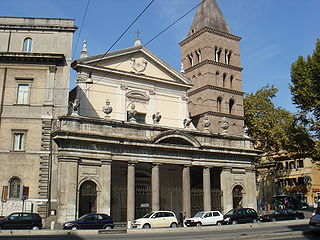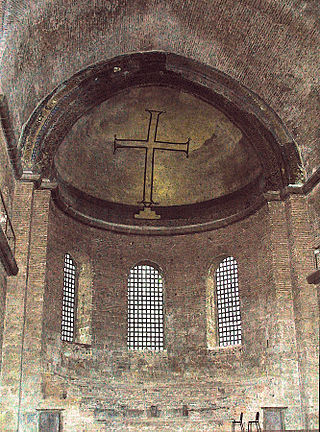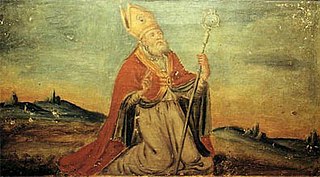Pope Adrian III or Hadrian III was the bishop of Rome and ruler of the Papal States from 17 May 884 to his death. He served for little more than a year, during which he worked to help the people of Italy in a very troubled time of famine and war.

The Second Council of Nicaea is recognized as the last of the first seven ecumenical councils by the Eastern Orthodox Church and the Catholic Church. In addition, it is also recognized as such by the Old Catholics, and others. Protestant opinions on it are varied.
The 380s decade ran from January 1, 380, to December 31, 389.

Year 544 (DXLIV) was a leap year starting on Friday of the Julian calendar. The denomination 544 for this year has been used since the early medieval period, when the Anno Domini calendar era became the prevalent method in Europe for naming years.

Pope Telesphorus was the bishop of Rome from c. 126 to his death c. 137, during the reigns of Roman Emperors Hadrian and Antoninus Pius. He was of Greek ancestry and born in Terranova da Sibari, Calabria, Italy.
Pope John XIII was the bishop of Rome and ruler of the Papal States from 1 October 965 to his death. His pontificate was caught up in the continuing conflict between the Holy Roman emperor, Otto I, and the Roman nobility. After long and arduous negotiations, he succeeded in arranging a Byzantine marriage for Otto II, in an effort to legitimize the Ottonian claim to imperial dignity. He also established church hierarchy in Poland and Bohemia.
Theodosius is a given name. It may take the form Teodósio, Teodosie, Teodosije etc. Theodosia is a feminine version of the name.

Otranto is a coastal town, port and comune in the province of Lecce, in a fertile region once famous for its breed of horses. It is one of I Borghi più belli d'Italia.

Oria is a town and comune in the Apulia region, in the province of Brindisi, in southern Italy. It is the seat of the Roman Catholic Diocese of Oria.

January 10 - Eastern Orthodox liturgical calendar - January 12

The Archdiocese of Otranto is a Latin archdiocese of the Catholic Church in Italy. The seat of the diocese is at Otranto Cathedral in the city of Otranto, Apulia. It is a suffragan of the archdiocese of Lecce.

San Crisogono is a church in Rome dedicated to the martyr Saint Chrysogonus. It was one of the tituli, the first parish churches of Rome, and was probably built in the 4th century under Pope Sylvester I (314–335).

The Byzantine Iconoclasm were two periods in the history of the Byzantine Empire when the use of religious images or icons was opposed by religious and imperial authorities within the Ecumenical Patriarchate and the temporal imperial hierarchy. The First Iconoclasm, as it is sometimes called, occurred between about 726 and 787, while the Second Iconoclasm occurred between 814 and 842. According to the traditional view, Byzantine Iconoclasm was started by a ban on religious images promulgated by the Byzantine Emperor Leo III the Isaurian, and continued under his successors. It was accompanied by widespread destruction of religious images and persecution of supporters of the veneration of images. The Papacy remained firmly in support of the use of religious images throughout the period, and the whole episode widened the growing divergence between the Byzantine and Carolingian traditions in what was still a unified European Church, as well as facilitating the reduction or removal of Byzantine political control over parts of the Italian Peninsula.

Barsanuphius, also known as Barsanuphius of Palestine, Barsanuphius of Gaza or Barsanuphius the Great, was a Christian hermit and writer of the sixth century.

The Archdiocese of Brindisi-Ostium is a Latin diocese of the Catholic Church in Apulia, has carried its present name since 1986. It is a suffragan of the archdiocese of Lecce.

The Diocese of Ugento-Santa Maria di Leuca is a Latin diocese of the Catholic Church in Apulia, has existed under this name since 1959. It is a suffragan of the Archdiocese of Lecce. The historic Diocese of Ugento has existed since the thirteenth century.

The Diocese of Oria is a Latin diocese of the Catholic Church in Apulia. It is a suffragan of the Archdiocese of Taranto.

Saint Leucius was initially a missionary from Alexandria, Egypt, who later founded the Diocese of Brindisi, as the first Bishop in 165. It is believed that he later suffered martyrdom in 180.
This is a timeline of the presence of Eastern Orthodoxy in Greece from 717 to 1204. The history of Greece traditionally encompasses the study of the Greek people, the areas they ruled historically, as well as the territory now composing the modern state of Greece.
San Francesco da Paola is a renaissance-style, former Roman Catholic church located in the town of Oria, province of Brindisi, Apulia, Italy.














